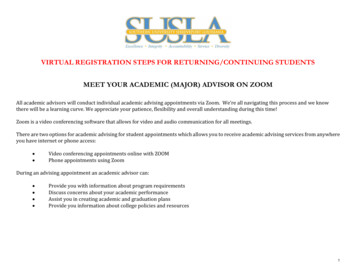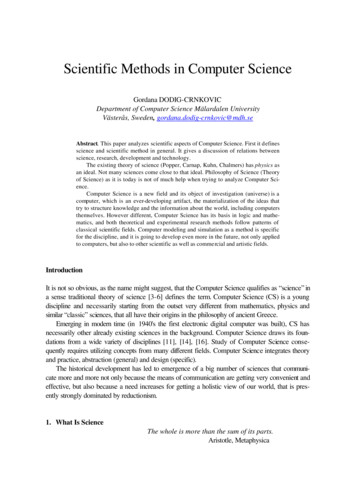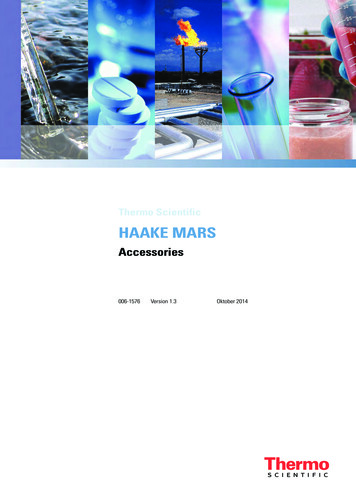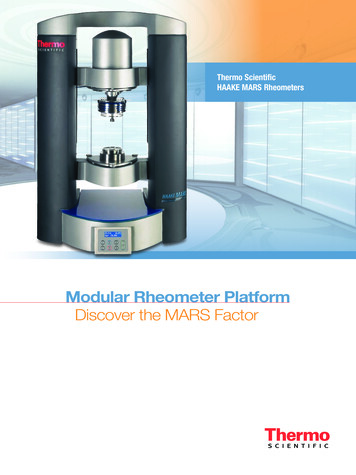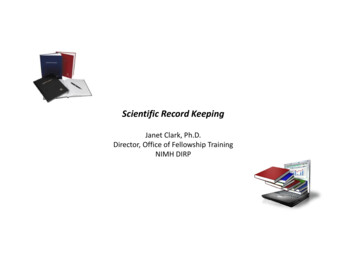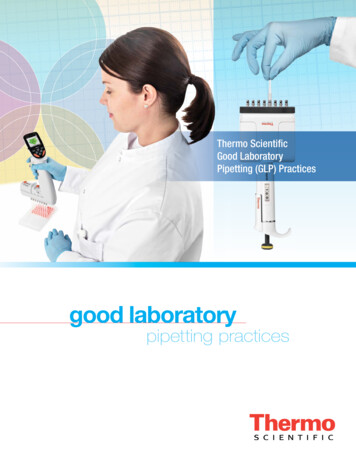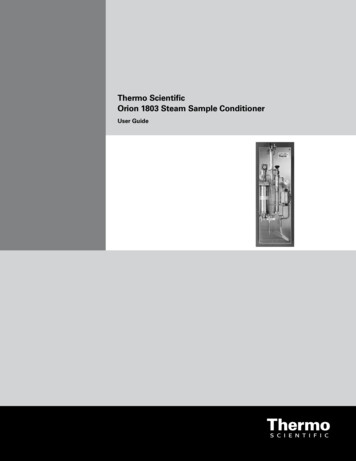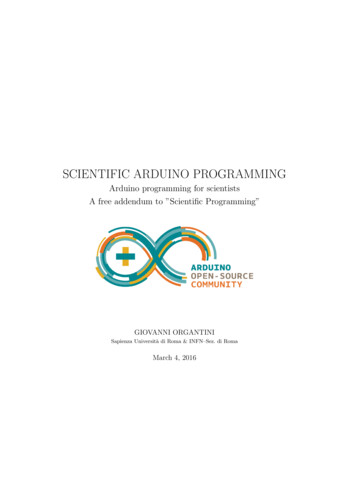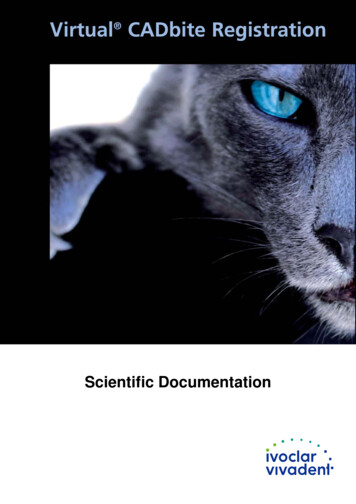
Transcription
Scientific Documentation
Scientific Documentation Virtual CADbite RegistrationPage 2 of 13Table of Contents1.Impression materials.32.Bite registration .33.Bite registrations for CAD/CAM procedures.44.Virtual CADbite Registration .45.Technical data.56.Properties of Virtual CADbite Registration .66.1Scannability . 66.2Hardness . 76.3Working and setting times . 76.4Tensile strength . 87.Clinic.118.Clinical experience with Virtual.129.Biocompatibility.12
Scientific Documentation Virtual CADbite Registration1.Page 3 of 13Impression materialsObtaining a highly accurate impression of the oral situation is crucial to the success ofindirect restorative procedures. The quality of impressions is dependent on both theexperience and skill of the clinician and the characteristics of the impression material used.State-of-the-art impression materials have to fulfil high requirements as far as reproduction ofdetail, tensile strength and stability are concerned.Various types of materials can be utilized for dental impression taking, e.g. hydrocolloidssuch as alginates, or polysulfides, polyether and silicones. Vinylpolysiloxanes belong to thefamily of addition-reaction silicones. When compared to the other materials mentioned, theyfeature a number of decisive advantages. These include: high precision good surface detail reproduction high tensile strength quick elastic recovery after deformation neutral taste and odour unaffected by liquid disinfectants different viscosities available adjustable setting timesRemoval of the impression from the mouth should be possible without distortion or tearing,and the impression should preserve its dimensional stability while being sent to the dentallab. There, a plaster replica of the oral situation is poured from the negative mould. Theplasters which are compatible with the impression material have to be listed in theinstructions for use.2.Bite registrationBite registrations are made to record the positional relationship of the upper and lower jawsto each other. Bite registrations help achieve successful restorations with harmonizedocclusion and articulation. To record the interocclusal jaw relationship, bite wax strips orplates have been and are still utilized. The wax used for this purpose should have amouldable consistency in the oral environment, but maintain its shape outside the mouth atroom temperature. Normally, the wax is softened by heating it prior to taking the wax bite.Instead of bite waxes, which are not very dimensionally stable, addition silicones can beused to take bite registrations. These materials offer the benefits mentioned above.
Scientific Documentation Virtual CADbite Registration3.Page 4 of 13Bite registrations for CAD/CAM proceduresApart from conventional impression taking, which serves the purpose of fabricating a plastermodel, there are digital impression taking procedures, which are employed in conjunctionwith the computer-aided design/computer-aided manufacturing (CAD/CAM) of toothrestorations. Digital impressions are taken either of the model in the dental lab, or directly inthe mouth at chairside using an intraoral scanning device or camera. In order to determinethe occlusal relationship, an antagonist bite registration is required. Being able to directlycapture images of this bite record with a scanning device or camera (without having to applya contrast medium) saves dentists considerable time and eliminates a possible source oferror. Examples of scannable bite registration materials are e.g. StoneBite Scan from Dreve,Metal-Bite from R-Dental or Kanibite Scan from Kaniedenta. All of these materials arevinylpolysiloxanes.4.Virtual CADbite RegistrationVirtual CADbite is a bite registration material with an addition-reaction polysiloxane(vinylpolysiloxane) base. The fillers it contains make the polymer more opaque and preventlight scattering. Therefore, images of the bite registration can be captured directly with alaser scanner. Based on these image data, the computer can calculate the occlusion of therestoration being fabricated.Virtual CADbite shows optimum readability when using a laser scanner from Sirona DentalSystems. Moreover, it features high strength and excellent reproduction of details.Fig.1: Virtual CADbite Registration
Scientific Documentation Virtual CADbite Registration5.Page 5 of 13Technical dataStandard Composition(in latinic complexSilicon dioxidePigmentFood dyes / aroma20 - 305 - 100.01 - 0.0540 - 5010 - 200.1 - 0.5Physical propertiesWorking time after mixing at 23 CMinimum time in mouthDetail reproductionShore D hardness (1h after setting)max. 30 sec.min. 45 sec.2 μm32 3
Scientific Documentation Virtual CADbite Registration6.Page 6 of 13Properties of Virtual CADbite RegistrationIn order to assess the suitability of Virtual CADbite for bite registration procedures, thematerial was tested and the results were compared with those of other well-proven materials.6.1ScannabilityNo utilizable optical record could be obtained by scanning the conventional bite registrationmaterial. Only after powdering the bite registration with IPS Contrast Spray, a satisfactoryimage could be captured. With the new Virtual CADbite, the same scanning result can beobtained in one step (Fig.2). The result is extraordinary. Because of the pigments used, thelaser beam is not scattered, which results in an image with sharp and crisp detail.Virtual Bite RegistrationVirtual Bite Registration withContrast SprayVirtual CADbite RegistrationFig.2: Scans of Virtual Bite Registration without and with Contrast Spray and of Virtual CADbiteRegistration.
Scientific Documentation Virtual CADbite RegistrationPage 7 of 136.2HardnessTo measure the hardness of Virtual CADbite, the Shore hardness test based on the Shore Dscale was used, which is the preferred method for more stiff rubbers/elastomers. Thehardness value is determined by pressing an indenter foot into the polymerized material witha force of 50 N at a temperature of 23 C for 15 sec. The depth of the indentation is measuredon a scale of 0 to 100. If the indenter completely penetrates the sample, a reading of 0 isobtained, and if no penetration occurs, a reading of 100 results.4540Shore D hardness35302520151050Virtual BiteRegistrationVirtual CADbiteMetal-BiteStoneBite ScanKanibite ScanFig.3: Shore D hardness of various bite registration materials (R&D, Ivoclar Vivadent, 2007)Of the materials compared in this chart, Metal-Bite exhibits the highest hardness. All theother materials show more or less the same hardness values. Hardness is frequently usedsynonymously with the dimensional stability of a specimen under a load. Clinically, all thematerials perform equally well.6.3Working and setting timesWorking and setting times of impression materials are measured with the oscillatingrheometer. Virtual CADbite is directly dispensed onto a measuring plate. The working time ismeasured at 23 C and 35 C, while the setting time is measured at 35 C. The proceduretakes account of the average temperature in the mouth.ProductVirtual BiteRegistrationVirtual CADbiteWorking time(@23 C, 5”)Setting time(@35 C, 5”)Setting time from start ofmixing(@35 C, 5”)50”28”86”36”23”76”Table 1: Working and setting times of Virtual Bite Registration and Virtual CADbite (R&D, IvoclarVivadent, 2007)
Scientific Documentation Virtual CADbite RegistrationPage 8 of 13Virtual CADbite has shorter working and setting times than the existing Virtual BiteRegistration material (Table 1). Quicker setting affords the advantage of ensuring a higherprecision of the impression. Moreover, it enhances patient comfort and thus patientcompliance for this type of procedure. An even shorter setting time would mean, however,that the dentist has to work very quickly.6.4Tensile strengthFor tensile strength measurements, test specimens with a bone-like shape are used (seeFig.4). The jaws of a Zwick tensile tester grip the specimens on both sides and exert asteady pulling force (10 mm/min). The tensile strength of a material is the maximum amountof tensile stress that it can be subjected to before failure. Additionally, elongation at breakand the tensile modulus can be determined.124202475Fig. 4: Test specimen for tensile strength measurement
Scientific Documentation Virtual CADbite RegistrationPage 9 of 137Tensile Strength /MPa6543210Virtual BiteRegistrationVirtual CADbiteMetal-BiteStoneBite ScanKanibite ScanFig. 5: Tensile strength values of different bite registration materials (R&D, Ivoclar Vivadent, 2007)25Elongation at break/%20151050Virtual BiteRegistrationVirtual CADBiteMetal-BiteStoneBite ScanKanibite ScanFig. 6: Elongation at break of different bite registration materials (R&D, Ivoclar Vivadent, 2007)
Scientific Documentation Virtual CADbite RegistrationPage 10 of 13It is interesting to note that all the measured materials demonstrate comparable tensilestrength values of around 5 MPa. The difference between the elongation at break values ismore pronounced. Elongation at break is closely related to fracture toughness. A highelongation at break value contributes to ensuring problem-free removal of a bite registrationfrom the mouth without distortion or tearing.Table 2 shows a comparison of tensile strength values. The tensile modulus correlates withthe hardness of the material.ProductTensilestrength(MPa)Elongation atbreak(%)Tensilemodulus(MPa)Virtual Bite RegistrationVirtual CADbiteMetal-BiteStoneBite ScanKanibite Scan5.2 1.14.8 0.55.5 1.14.5 0.64.5 0.919 421 213 38 111 131 124 149 459 245 3Table 2: Comparison of values obtained in tensile tests.
Scientific Documentation Virtual CADbite Registration7.Page 11 of 13ClinicThe handling of Virtual CADbite was tested in the internal clinic of Ivoclar Vivadent. Below, aclinical case is presented by means of the series of pictures (Fig.7). Teeth # 46 and 47 of thepatient which had been restored with amalgam showed secondary caries. After removal ofthe defective fillings and preliminary preparation of the teeth, a bite record was taken withVirtual CADbite. Since the opposing dentition had an irregular appearance, an antagonistbite registration was particularly helpful in this case. The antagonist was displacedpalatinally.Prior to completing cavity preparation, a rubber dam was placed to ensure a completely dryoperating field for the adhesive procedures planned. Now it was safe to fill the undercuts andline the dentinal areas in the centre of the cavity with flowable composite. For this purpose,the cavity was conditioned with AdheSE. Next, Tetric EvoFlow was applied to the undercutsand dentinal areas in the cavity centre. The composite increments were cured with thebluephase LED curing unit in the LOW power mode. This was followed by finishing of thecavity margins, removal of the remaining stains and finishing of the reconstructive lining.Subsequently, the prepared teeth were powdered with Contrast Spray for the opticalimpression taking procedure. Then images were captured with an intraoral scanning device.The completed bite registration was trimmed with a scalpel and seated on the preparations.The digital impression of the prepared teeth with the bite registration in place could be takenwithout having to apply an additional coat of powder.Based on the data obtained, the inlay was digitally constructed using Cerec software andsubsequently milled from IPS Empress CAD ingots.Pre-operative situation: Amalgam fillings in teeth# 46 and 47 showing secondary cariesBite registration with Virtual CADbiteSituation after preparation of the cavity and priorto filling the undercutsCompleted preparation with IPS Contrast Sprayprior to optical impression taking
Scientific Documentation Virtual CADbite RegistrationVirtual model of prepared tooth # 47Page 12 of 13The completed inlay after virtual constructionFig. 7: Photo documentation of a clinical case8.Clinical experience with VirtualVirtual was launched in 2002 and has in the meantime established itself in the marketplaceas a high-precision impression material. It acts like a hydrophilic material which, at the sametime, exhibits excellent moisture displacement capabilities (see Scientific Documentation ofVirtual). As a result, highly accurate impressions are achieved. The fresh peppermint scent isperceived as pleasant and calming by patients.9.BiocompatibilityPolysiloxanes are generally described as being chemically inert and biocompatible. Celltoxicity tests of the individual components were conducted. The results revealed that thematerials used as ingredients in Virtual do not show a
Scientific Documentation Virtual . The jaws of a Zwick tensile tester grip the specimens on both sides and exert a steady pulling force (10 mm/min). The tensile strength of a material is the maximum amount of tensile stress that it can be subjected to before failure. Additionally, elongation at break and the tensile modulus can be determined. 20 24 75 12 4 Fig. 4: Test specimen for tensile .
